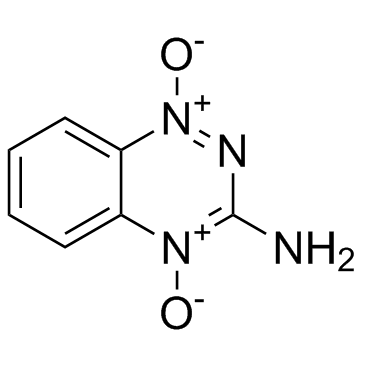Tirapazamine

Tirapazamine structure
|
Common Name | Tirapazamine | ||
|---|---|---|---|---|
| CAS Number | 27314-97-2 | Molecular Weight | 178.148 | |
| Density | 1.7±0.1 g/cm3 | Boiling Point | 493.6±28.0 °C at 760 mmHg | |
| Molecular Formula | C7H6N4O2 | Melting Point | 220ºC | |
| MSDS | Chinese USA | Flash Point | 252.3±24.0 °C | |
| Symbol |

GHS07 |
Signal Word | Warning | |
|
An innovative three-dimensional gelatin foam culture system for improved study of glioblastoma stem cell behavior.
J. Biomed. Mater. Res. B. Appl. Biomater. 103(3) , 618-28, (2015) Three-dimensional (3-D) tissue engineered constructs provide a platform for examining how the local extracellular matrix contributes to the malignancy of various cancers, including human glioblastoma multiforme. Here, we describe a simple and innovative 3-D c... |
|
|
Tirapazamine-doxorubicin interaction referring to heart oxidative stress and Ca²⁺ balance protein levels.
Oxid. Med. Cell. Longev. 2012 , 890826, (2012) Doxorubicin (DOX) causes long-term cardiomyopathy that is dependent on oxidative stress and contractility disorders. Tirapazamine (TP), an experimental adjuvant drug, passes the same red-ox transformation as DOX. The aim of the study was to evaluate an effect... |
|
|
Exploiting tumour hypoxia and overcoming mutant p53 with tirapazamine.
Br. J. Cancer 77 Suppl 4 , 12-4, (1998) Human solid tumours are composed of a significant proportion of hypoxic cells, i.e. cells with oxygen levels lower than those of normal tissues. Tumour hypoxic cells have been shown to have a negative impact on the response of solid tumours to radiation thera... |
|
|
A hybrid cellular automaton model of solid tumor growth and bioreductive drug transport.
IEEE/ACM Trans. Comput. Biol. Bioinform. 9(6) , 1595-606, (2012) Bioreductive drugs are a class of hypoxia selective drugs that are designed to eradicate the hypoxic fraction of solid tumors. Their activity depends upon a number of biological and pharmacological factors and we used a mathematical modeling approach to explo... |
|
|
Hypoxia-dependent retinal toxicity of NLCQ-1 (NSC 709257) in BALB/c mice. Comparison with tirapazamine.
Basic Clin Pharmacol Toxicol. 108(6) , 396-9, (2011) Bioreductive drugs can cause retinal toxicity, mediated by extensive apoptosis in the outer retina of rodents and monkeys. In the present study, we have investigated whether or not the novel and promising hypoxia-selective cytotoxin 4-[3-(2-nitro-1-imidazolyl... |
|
|
Effects of tirapazamine on experimental colorectal liver metastases after radiofrequency ablation (Br J Surg 2012; 99: 567-575).
Br. J. Surg. 99(4) , 576, (2012)
|
|
|
Uroporphyrinogen decarboxylase: optimizing radiotherapy for head and neck cancer.
Future Oncol. 7(5) , 595-7, (2011)
|
|
|
Is there a role for tirapazamine in the treatment of cervical cancer?
Expert Opin. Drug Metab. Toxicol. 8(12) , 1589-97, (2012) Cervical cancer is the second-most common malignancy in women worldwide. Cisplatin was introduced as a radiosensitizer in 1999 to improve chances of survival. Tumor cell hypoxia, however, remains a major limiting factor in the treatment of solid tumors with c... |
|
|
A Planned Neck Dissection Is Not Necessary in All Patients With N2-3 Head-and-Neck Cancer After Sequential Chemoradiotherapy
Int. J. Radiat. Oncol. Biol. Phys. 83(3) , 994-9, (2012) Purpose To assess the role of a planned neck dissection (PND) after sequential chemoradiotherapy for patients with head-and-neck cancer with N2–N3 nodal disease. |
|
|
Usefulness of combined treatment with continuous administration of tirapazamine and mild temperature hyperthermia in γ-ray irradiation in terms of local tumour response and lung metastatic potential.
Int. J. Hyperthermia 28(7) , 636-44, (2012) To evaluate the usefulness of combined treatment with continuous administration of a hypoxic cytotoxin, tirapazamine (TPZ), and mild temperature hyperthermia (MTH) in γ-ray irradiation in terms of local tumour response and lung metastatic potential, referring... |